Japan's Official Development Assistance White Paper 2005
Main Text > Part I JAPAN'S EFFORTS TOWARD ACHIEVING THE MILLENNIUM DEVELOPMENT GOALS (MDGs) > Chapter 2 Specific Measures by Japan toward Achieving the MDGs > Section 3. Japan's Contribution in Social Sectors Related to the MDGs
Section 3. Japan's Contribution in Social Sectors Related to the MDGs
As seen in the previous section, sustainable economic growth is necessary to achieve the MDGs. Support for efforts such as infrastructure development, investment climate development, and the revitalization of private sector activities contributes to the whole economy of developing countries. In addition to this kind of support, it is also indispensable to focus directly on poor regions and to improve not only the level of incomes but also the access to basic social services. Therefore Japan's efforts in social sectors related to the MDGs (particularly numbers two to seven will be discussed below), presenting projects to which Japan has provided cooperation.
Chart 9. List of Current Sector-specific Initiatives

(1)Achieve Universal Primary Education (Goal 2)
Education is one of the major factors both in promoting the empowerment of individuals and in bringing about national development. Japan has therefore actively contributed to the human resource development of developing countries. Specifically, Japan announced in 2002 that it would offer over ¥250 billion in ODA in the area of education 15 to low-income countries over the next five years. In particular, basic education is essential for people to acquire knowledge, values and skills necessary for surviving, sufficiently utilizing their capabilities, and leading a dignified life. Based on this perspective, Japan has utilized its experience on the basis that human resource development is fundamental for nation-building, and has strengthened its efforts to promote education. For example, in 2002, Japan announced the Basic Education for Growth Initiative ( BEGIN ).
Enhancement of the Capacity of Teachers in Honduras
In Latin America, while the net primary enrollment ratio 16 exceeds 90% on average according to surveys by the United Nations Educational, Scientific, and Cultural Organization ( UNESCO ), these countries have serious problems such as school drop-outs and grade repeaters, besides such challenges as wide disparities in the quality of education among regions, classes, and ethnic groups. In Honduras in particular, the number of children who completed primary education in the standard numbers of years remained as low as 31.9% as of 2000. The government, therefore, announced a goal of "ensuring access to and completion of six years of primary education for all school-age boys and girls by 2015," and has been implementing a variety of initiatives in cooperation with donor countries and multilateral organizations. Japan has also been providing active assistance to these efforts.
In Honduras, there are a large number of school drops-outs and grade repeaters due to underachievement particularly in the national language (Spanish) and mathematics. It is pointed out that low-quality teachers are one of the factors behind this problem. In order to improve the teaching ability of incumbent teachers, Japan has been dispatching the Japan Overseas Cooperation Volunteers ( JOCVs ) since 1989 to provide training to them, and has also been providing grant aid for the construction of the National Institute for Education Research ( NIER ). Additionally, in 2003, Japan commenced the "Improvement of Mathematics Teaching Methods" project, the major elements of which are the creation of manuals for mathematics teachers and mathematics drills for children, teacher training to improve the basic academic and teaching abilities of teachers by using these materials, and the building of an educational evaluation method.
In 2005, the third year of the project, the manuals for mathematics teachers and the mathematics drills for elementary school students from grades one to six have been completed and distributed throughout the country as official textbooks.
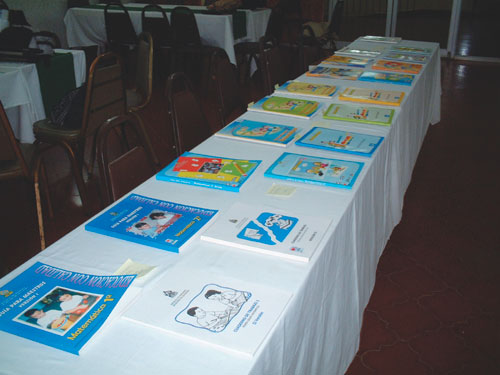
The completed manuals and mathematics drills
These results have interested other donor countries and international organizations based in Honduras, and have promoted collaborations between them. For example, under the leadership of the Government of Honduras, Sweden and Canada offered to cover the costs of the nationwide distribution of the manuals and drills. In addition, concerning the core teacher training, Spain has enabled incumbent teachers receiving its training course to also participate in the training course of the Japan project. The United States Agency for International Development ( USAID ) also sends its Honduran staff to participate in the training course. The Honduras Vice-Minister of Education praised this project with the following remarks, "This was the first example ever seen in Honduras of the collaborating network between the Honduras side, represented by the Ministry of Education and the University of Education, and donors such as Japan. The partnership between Honduras and the donors has therefore, been strengthened."
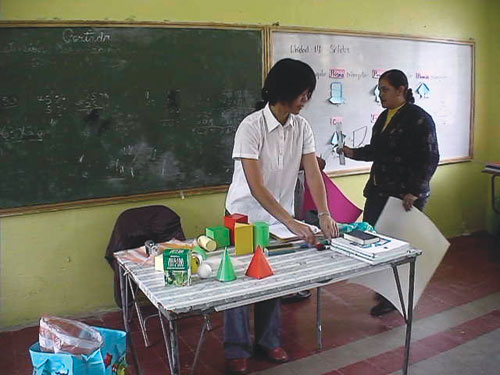
Teacher training by JOCV members. Training Programs contain not only lectures but also practical work.
The results of the "Improvement of Mathematics Teaching Methods" project were widely perceived by the people involved in education in neighboring countries, and in 2003 the project was mentioned in the Council of Ministers of Culture and Education of Central America. As a result, neighboring countries such as Nicaragua and El Salvador made requests to Japan for the same kind of technical cooperation, which Japan decided to implement in 2005. The Dominican Republic, where Japan had already decided to implement a project, requested similar cooperation to be implemented as a regional effort, crossing neighboring countries. Therefore Japan accepted to implement the project as regional cooperation. In this manner, Japan's cooperation for improvement of mathematics teaching ability has become recognized as a form of regional cooperation for the Central American region.
In this way, "Improvement of Mathematics Teaching Methods," focusing on the improvement of teaching ability, one of the important issues in the education sector, has achieved results based on the contributions of the JOCVs over the past 15 years. As a form of regional cooperation incorporating neighboring countries, this project has finally come to contribute to achieving the MDGs in the Central American region. This project is a good example of Japan's cooperation in the education sector, spreading from Japan to other donors on one hand, and expanding from Honduras to other Central American countries on the other.
(2) Promote Gender Equality and Empower Women (Goal 3)
In the world, women account for approximately 70% of the 1.1 billion people living in poverty and approximately two-thirds of all illiterate people. From this perspective, it is pointed out that women are in a relatively bad situation compared to men. Due to the social and economic disparities between men and women and the customary divisions of labor, men and women differ both with respect to developmental needs and the impact of development. For these reasons, when providing development assistance, it is important to make efforts to support women, while taking into account the perspective of gender equality, even if the measures do not directly address issues of women and gender.
Since it announced the Initiative on WID (Women in Development) in 1995, Japan has been providing support with a primary focus on the three priority areas of education, health, and economic and social participation of women, and has been working to integrate women into the development process. In the eight years between 1996 and 2003, a total of approximately US$7.2 billion was allocated for support related to these sectors. The ODA Charter revised in 2003 clearly states that the perspective of gender equality and the improvement of the status of women are basic policies of ODA. In March 2005, the WID Initiative was revised and newly formulated as the Initiative on Gender and Development ( GAD ), in order to incorporate the gender perspective in all phases and sectors of ODA and to strengthen support for efforts toward gender equality and the empowerment of women in developing countries (Refer to Part II, Chapter 2, Section 1 for details).
Efforts to Empower Women in Afghanistan
In Afghanistan, one of the world's poorest countries where approximately half of the people suffer from malnutrition, women have been subjected to discrimination for many years under the Taliban regime. For example, they were denied the opportunities to go to school or get a job. As of 2004, the maternal mortality rate in the country is at the lowest level in the world with 1 out of every 50 women dying, and the school attendance rate for girls is at a low level of 40%. Moreover, the illiteracy rate for women above 15 years of age is the third highest in the world at approximately 80%, and the occupations of women are largely limited to educational and medical sectors. In addition, for poor women and those whose husbands have died in the conflict in the past 20 years, there are very few ways to earn a living.
In response to this situation, Japan has been providing support for policy-making and institution-building from a gender perspective to improve the status and life of Afghan women. 17 For example, since 2002 Japan has dispatched nine experts to the newly-established Ministry of Women's Affairs, working for gender equality, and providing cooperation to strengthen the capacity for policy formulation of the Ministry. Japan's experts have been giving advice to the Minister of Women's Affairs, developing partnerships with related organizations, gathering information concerning capacity development of women, and examining and proposing support measures for women. Having received this cooperation from Japan, the Ministry of Women's Affairs has begun to formulate a full range of policies to achieve gender mainstreaming. 18 The new Afghan constitution, adopted in January 2004, incorporates gender equality, a guarantee of women's rights to participate in politics, and the participation of women in education up to the tertiary level. During the process of drafting, Japan dispatched experts to share Japan's experience of guaranteeing women's rights through provisions in its own constitution.
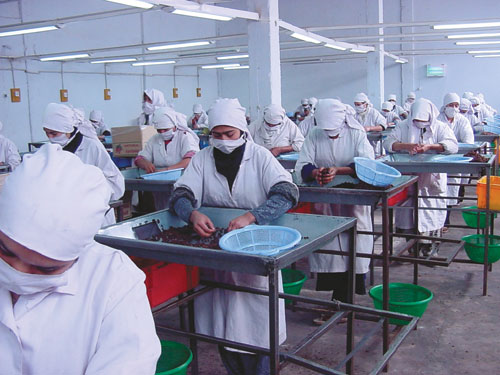
Afghan women working in a raisin factory. Working opportunities for women are increasing in Afghanistan.
Furthermore, in February 2005, Japan commenced the Project on Enhancing Women's Economic Empowerment with a view to restoring women's rights and building the economic independence of poor women, especially in conservative regions. This project aims to strengthen the capacity of the various regions and the central government. It is planned to continue until 2008, conducting the Community Empowerment Program for Women in three provinces in Afghanistan with relatively stable security situations (Bamiyan, Balkh, and Kandahar). The Program aims to expand opportunities for women to participate in economic activities and increase their freedom to choose an occupation. Specifically, Japan has been cooperating with the Department of Women's Affairs ( DOWA ), which is the local agency of the Ministry of Women's Affairs in each province, to help women with organizing groups and establishing their own businesses. Furthermore, Japan has been supporting the improvement of the environment which enables the Ministry of Women's Affairs to gather issues and needs of women through the DOWA and promote women's economic activities in partnership with related ministries, agencies, and other organizations. An expert who participated in these projects said, "Afghanistan is ethnically diverse and each region has its own special characteristics. I would like to support Afghan people to develop activities that reflect the needs and views of women in the regions and to put in place the social infrastructure that will make these kinds of activities possible."
As mentioned above, Japan has been not only implementing individual projects, but also supporting policy efforts toward gender equality in Afghanistan and contributing to the building of a society in which women can live their lives with safety and dignity.
(3) Reduce Child Mortality (Goal 4), Improve Maternal Health (Goal 5), Combat HIV/AIDS, Malaria, and Other Diseases (Goal 6)
The health sector has been given a particularly important position in the MDGs, with three of the eight goals related to maternal and child health and infectious diseases. This reflects the fact that in developing countries health is not only an issue related to individuals, but also a pressing issue from the perspective of ensuring human resources for development. Japan provided support of US$4.1 billion in the health sector over four years from July 2000 to March 2004, based on the Okinawa Infectious Diseases Initiative ( IDI ) announced in 2000. This amount significantly exceeded the target originally planned in the IDI of US$3 billion over five years. Furthermore, in June 2005 Japan announced the Health and Development Initiative, focusing more on support for the efforts of developing countries to achieve the health-related MDGs, and expressed its intention to provide comprehensive assistance amounting to US$5 billion over the next five years. Based on this initiative, Japan will continue to strengthen its support for the efforts of developing countries to achieve the health-related MDGs. This includes support for the infrastructural development of health systems and support for complementary sectors related to the health sector efforts.
Box 3. Summary of High-Level Forum (HLF) on Health MDGs in Asia and the Pacific
A. Maternal and Child Health
Many children and pregnant women die of preventable and treatable diseases in developing countries. 19 In addition, many of the families left behind are struggling to pay high medical costs. Japan has reduced its infant and maternal mortality rates to the lowest level in the world since the end of World War II. Japan utilizes such experience to provide support for the improvement of maternal and child health in developing countries.
Maternal and Child Health Handbooks in Indonesia
In Indonesia the maternal mortality rate has been so high that improvement in the maternal health and enhancement of health care services has been required. In light of this situation, Japan implemented Ensuring the Quality of MCH (Maternal and Child Health) Services Through Handbook (1998-2003) in Indonesia with the goals of utilizing handbooks to increase mothers' knowledge concerning health and hygiene, and to improve maternal and child health care services. This project was initiated by an Indonesian doctor who had come to Japan as a JICA trainee and was deeply impressed by Japan's Maternal and Child Health Handbook system. The predecessor of the Maternal and Child Health Handbooks currently used in Japan was the Maternal Handbook, which was devised in 1942 in order to improve the situation there were approximately 300,000-350,000 miscarriages and stillbirths, 5,000 maternal deaths, and 60,000 infant deaths resulting from premature birth annually (as of 1938). The handbook has played an important role in the improvement of maternal and child health in Japan as a health record book starting from pregnancy and childbirth to after birth, and as a manual for precautions in daily life during pregnancy, childbirth, and in raising children. As a result of Japan's experience and suggestions by JICA trainees, movement toward the creation of the Maternal and Child Health Handbooks gathered momentum in Indonesia and the development of these handbooks has been promoted.
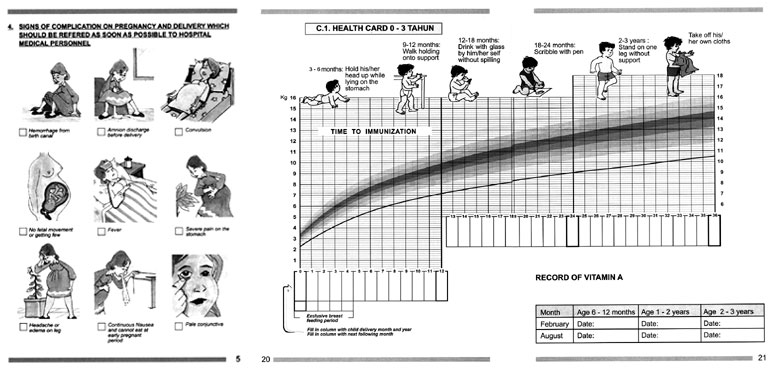
Photograph of the inside of a Maternal and Child Health Handbook
Regarding the characteristic features of the Maternal and Child Health Handbooks in Indonesia, there are sections to record the state of maternal health and the height and weight of each child after birth. The Handbooks are designed for illiterate mothers living in poor regions to easily understand the contents, and thus feature many illustrations and avoid using difficult medical jargon. They also include information about postnatal child-rearing methods, so they can also be utilized as maternal child-rearing manuals. The Maternal and Child Health Handbooks distributed on a trial basis in Central Java Province in February 1994 were well-received by the residents and were highly praised as being useful not only for the health management of pregnant women, but also for improving knowledge and proficiency with respect to childbirth and child-rearing.
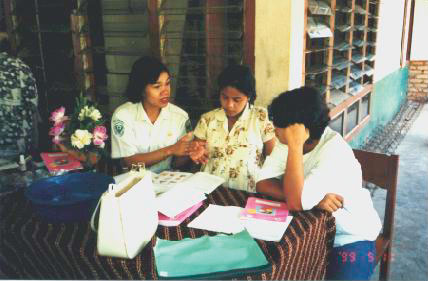
Medical staffs instructing a pregnant woman using MCH
The Maternal and Child Health Handbooks system had spread to more than two-thirds of the provinces of Indonesia by FY2003 and today, 1 million copies are distributed every year. Furthermore, in March 2004 the Government of Indonesia formulated the Health Minister's declaration concerning the Maternal and Child Health Handbooks, which instructed health-care professionals to record the state of maternal and child health in the handbooks. The declaration also required the central and regional governments to distribute the handbooks to all pregnant women, without charge to poor citizens in particular. One mother who actually uses the handbooks says, "I like it so much. It is good because it tells me about maternal and child health and danger signs with a lot of pictures. In particular, I was impressed by the way the fetus looked in the womb."
Chart 10. Current Status of Maternal and Child Health Worldwide

As such, Japan's Maternal and Child Health Handbook system has widespread among the Indonesian people and contributed to maternal and child health in the country by strengthening the health management capability of pregnant women. As of 2000, these efforts have allowed the maternal mortality rate in Indonesia to decline to 1 maternal death out of every 500 births, half as many as it was in the first half of the 1990s, although it remains high compared to the indicator of the average for Asia and Oceania of 1 maternal death out of every 900 births. 20 The Maternal and Child Health Handbooks have been developed and disseminated not only in Indonesia but also in the Philippines and Mexico through JICA, producing positive results in these places, as well.
B. Infectious Diseases
Without appropriate measures, there is a danger that infectious diseases will cross national borders and spread throughout regions and the world as a whole in this age of globalization. Infectious diseases are not only an issue for developing countries but also a global issue that could affect Japan. It is therefore necessary to build close partnerships and cooperative systems among regions.
Measures to Combat Malaria in Sub-Saharan Africa
Currently approximately 1 million people die of malaria each year, and approximately 90% of the victims are concentrated in Sub-Saharan Africa. Particularly, children in the area die at the rate of 1 every 30 seconds. It is pointed out, therefore, that malaria is one of the major causes of death in terms of all infectious diseases.
In the context of this serious situation, mosquito nets traditionally used in Japan attract attention as an effective method for combating malaria. According to UNICEF, if insecticide-treated mosquito nets are used properly, the risk of infection can be reduced by over 60%. Moreover, reportedly, if the number of infected mosquitoes is reduced, the infection rate of those who do not use mosquito nets will also decline. 21 Therefore, Japan has provided approximately 2.1 million mosquito nets to developing countries since 2003 through bilateral assistance, and UNICEF and has further decided to provide a total of 10 million long-lasting insecticide-treated nets ( LLINs ) by 2007. UNICEF estimates that this measure will protect 20 million children from malaria and decrease the number of child deaths by between 110,000 and 160,000 a year. Distribution of mosquito nets is stated at the beginning of the Quick Win Actions for realization of the MDGs by 2015, advocated in the Millennium Project Report published in January 2005.
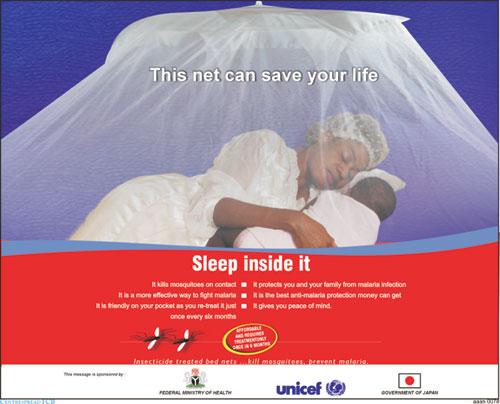
Publicity photograph for the Roll Back Malaria campaign in Nigeria
In order to achieve the MDGs, it is necessary not only to provide mosquito nets, but also to strive to ensure that people in developing countries use the nets in daily life. Therefore, for example, Japan has provided support through the Trust Fund for Human Security to the Malaria Control with an Emphasis on Insecticide Treated Bednets ( ITNs ) and Household Management of Malaria by Mothers Project. This project has been implemented in Nigeria which, with a population of 130 million people, is the most populous country in Africa and where 400,000 children die of Malaria every year. In order to establish mosquito net use as a method for preventing malaria and improve household management of malaria, the project has provided support for the production of ITNs in Nigerian factories, created demand for ITN use, and raised awareness about home management of malaria. As a part of these activities, an education campaign has been conducted through Nigeria's private sector companies since 2003 in which newspaper advertisements, billboards, television dramas, and commercials have been created, calling for mosquito net use. One woman user of the nets says, "I do not want to get malaria myself, but even more my children. So if my ITN gets torn I will buy a new one."
In this way, Nigerian people who previously had no custom of using mosquito nets have come to use them widely as an effective method for preventing malaria.
Regarding international efforts to combat malaria, WHO, UNICEF, the World Bank and the UNDP jointly commenced the Roll Back Malaria campaign in 1998, aiming to reduce deaths of malaria by 50% by 2010. As a part of the campaign to raise awareness, the Africa Live concert calling for the eradication of malaria was held in March 2005 with the participation of African musicians, in Dakar, Senegal.
(4) Ensure Environmental Sustainability (Goal 7)
Chart 11. Transnational Environmental Issues

A. Reversing the Loss of Environmental Resources
Given that many of the poor people in developing countries live in rural areas and their lives depend on natural resources, it is vital to reduce the loss of environmental resources. Japan has been utilizing its experience, technology and human resources to support the efforts of developing countries toward sustainable development. Having announced the Environmental Conservation Initiative for Sustainable Development ( EcoISD ) in 2002, Japan has been providing support for measures to deal with air pollution arising from economic development, measures to overcome poverty, which is one of the root causes of environmental problems, and responses to global-scale environmental problems such as global warming and the loss of biodiversity. In FY2004 Japan's ODA in the environmental sector amounted to approximately ¥444 billion, which was 39.2% of the total ODA in that year.
Afforestation Projects in Southern India
As for India, which achieved a GDP growth rate of 8.5% in FY2003 and is experiencing remarkable economic development, compatibility between development and environmental protection has become a major challenge. Until the latter half of the 1980s, India had given priority to economic interest and continued logging in forests. As a result, India's forest area ratio 22 declined to the current rate of approximately 22%, below the world average of 30%. In India, approximately 1 million people depend on forest resources for their livelihood and many of the poor live on the fringes of forests. Those poor people will suffer from the deterioration in the water and soil conservation functions of the forests caused by deforestation and water shortages.
Taking this situation into account, in 1997 the Government of Japan in partnership with NGOs extended yen loan to Tamil Nadu Afforestation Project in southern India's Tamil Nadu State. The project implemented afforestation of approximately 450,000 hectares, equivalent to approximately twice the size of Tokyo. Afforestation was carried out jointly with local residents and the state's Forest Department. Capacity building was also achieved, for example in Forest Management Associations, to encourage the participation of villagers and provide education necessary for the regeneration and proper usage of forests.
In order to ensure sustainable regeneration and proper usage of forests, it is necessary to ensure the alternative sources of income for residents while supporting their self-help efforts. For this reason Japan has supported increases in incomes through livestock farming in each Forest Management Association. In particular, Japan has endeavored to enable the participation of female residents who rely most heavily upon forest resources in their daily lives, by creating self-help organizations for women within the Association. Poor women who participated in the organizations found ways to earn alternative income, for example form selling milk, and the sense of solidarity among women also improved. One member of a self-help organization said, "I have learned a lot through the afforestation project. I have learned about the importance of nurturing and protecting the forest and saving money for the future. Most importantly my life has improved because I have a stable income now. Through the project, I was able to participate in a variety of events and obtain knowledge."
As described above, the Tamil Nadu Afforestation Project is one example of projects that have contributed to the poverty reduction and the empowerment of women through activities centered on environmental conservation. This project was highly appreciated in India, and in 2003, the Government of India certified it as one of the best practice projects contributing to the improvement of governance. Furthermore, it has been confirmed that on the occurrence of the Indian Ocean tsunami following large-scale earthquake off the coast of Sumatra, Indonesia in December 2004, this afforestation project contributed to reducing the damages in coastal areas.
B. Supply of Safe Drinking Water and Basic Sanitation
Japan has been the largest donor regarding the water sector development, as it is utilizing its technology and know-how to provide cooperation such as ensuring water supplies and developing water supply infrastructure. Furthermore, based on the 'Initiative for Japan's ODA on Water' announced in 2003, Japan has advanced a comprehensive approach, which includes the effective use of water resources, water pollution control, flood and landslide mitigation, and water resources management. Between 1990 and 2003, it provided approximately US$14 billion in support, which is equivalent to 45% of the share of the DAC countries. Such support not only contributes to ensuring access to safe drinking water, Goal 7 of the MDGs, but also contributes to other MDGs, such as the reduction of child mortality and measures against infectious diseases.
Water Management in Senegal
There are approximately 1.1 billion people in the world without access to safe water today. This figure is as high as 300 million people in Sub-Saharan Africa, which is equivalent to over 40% of its population. In order to achieve MDGs, therefore, it is essential to improve the situation in this region, among which is Senegal, an arid region located at the western end of the Sahel (the southern edge of the Sahara desert), where many residents in rural areas depend on shallow wells for water supply. A number of waterborne diseases occur due to polluted surface water, and in dry season many people suffer from wells running dry.

A water supply tower constructed with Japan's ODA (Photo: JICA)
Chart 12. Contributions in the Water and Sanitation Sector of Donor Countries

Chart 13. Percentage of People with Access to Safe Drinking Water (2002)

Japan has built water supply facilities in 109 villages throughout Senegal for over 25 years since 1979. These facilities have contributed to reducing waterborne diseases, such as diarrhea and skin diseases, and have established more hygienic livelihood in local communities in Senegal. Furthermore, the burden of water-drawing on many women and children has been reduced, so the primary school attendance rate has improved, and the income of women has increased because of their part-time jobs. In this way, the quality of lifestyles has greatly improved in this area. Japan's support to Senegal has therefore contributed not only to the MDGs target of supplying safe water, but also to the achievement of other goals such as the achievement of universal primary education and the empowerment of women.
As pointed out in the MDGs, in order to ensure sustainable safe water supply essential for daily life, it is necessary not only to construct and develop water facilities, but also to enhance the capacity for an effective operation and maintenance of these facilities by local people. For this purpose, Japan has been implementing the Project on the Safe Water and the Support on Community Activities since 2003. Through the project which aims to establish sustainable water usage system in rural areas, Japan has been providing technical assistance for establishment of operational systems for a water management cooperative which operates the water supply facilities.
Through this project, Japan has been providing technical support for the development of water pumps so that rural residents can maintain the water supply facility independently. At the same time, the project focuses on capacity development of the counterpart personnel, so that the water supply facilities can be operated with community members as well. The water management cooperative, as an organization run with the participation of local people, strives to select members democratically and to increase the transparency of their operations by thorough information disclosure. A woman in charge of accounting of the cooperative says, "We sense a mission to protect the water supply facility, because it is women that receive the most benefit from the building of the facility." Moreover, through the project, Japan has been supporting productive activities, such as poultry farming in the community organizations. These organizations use as start-up capital the surplus funds from the water charges which have been collected by the water management committees.
In this way, local people in Senegal have started to make self-help efforts to develop the entire community. They take their measures to maintain and manage the water supply facility constructed with Japan's ODA, implement profit-making activities, and invest in the infrastructure for the community. These efforts in Senegal are examples of support based on the perspective of human security for the sake of protecting local people from water scarcity and simultaneously in enhancing the capacity of individuals to lead in village development.
As mentioned in this section, Japan has been contributing to the achievement of the MDGs by combining various kinds of assistance. Based on these contributions, Japan will continue to enhance its cooperation in the future as well. The next section presents some of Japan's newly announced measures toward achieving the MDGs.
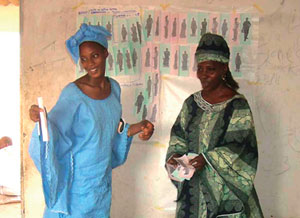
Women of water management cooperative (Photo: JICA)
Box 4. Japan's Efforts Regarding MDG8


 Next Page
Next Page